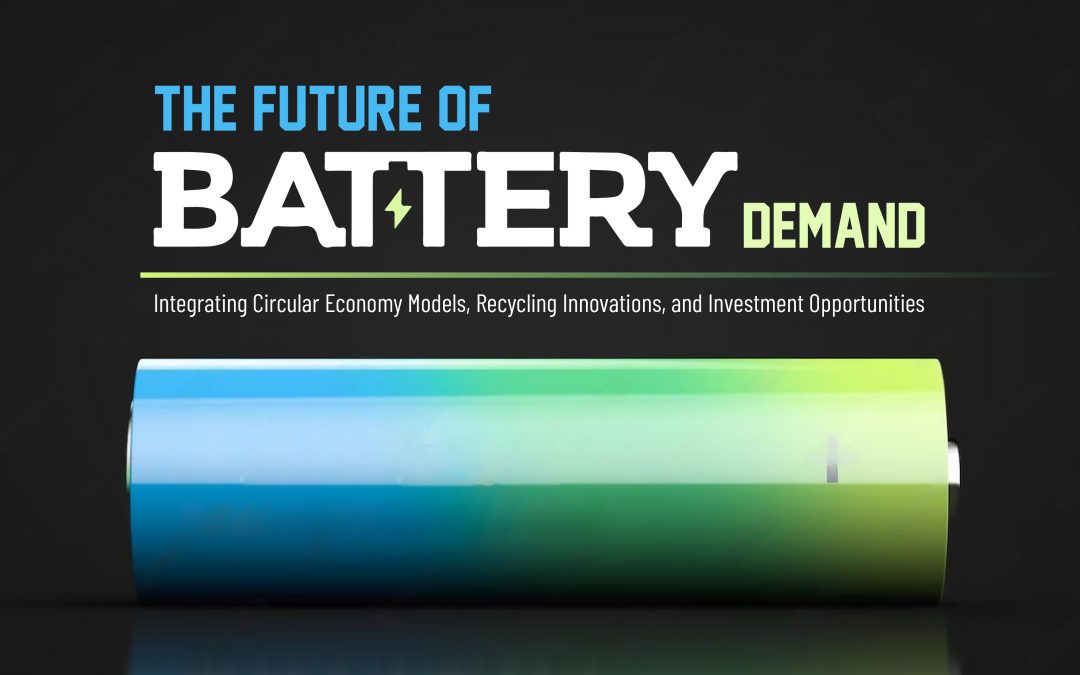As the world rapidly transitions towards renewable energy, electric vehicles (EVs), and smart devices, the demand for batteries is skyrocketing. This surge brings with it not only environmental challenges but also significant business opportunities. Understanding the future of battery demand involves exploring how circular economy models, recycling innovations, and strategic investment can shape a sustainable and profitable landscape.
The Growing Demand for Batteries
The global battery market is projected to grow exponentially, driven by the increased adoption of EVs, renewable energy storage solutions, and the proliferation of consumer electronics. Batteries are the cornerstone of this energy transition, but their production and disposal pose significant environmental challenges. The mining of raw materials like lithium, cobalt, and nickel is resource-intensive and environmentally damaging. Additionally, the disposal of used batteries contributes to hazardous waste, highlighting the need for sustainable solutions.
Integrating Circular Economy Models
A circular economy model focuses on designing products and systems that minimize waste and make the most of resources. In the context of batteries, this means extending the life cycle of materials through reuse, remanufacturing, and recycling. By adopting circular economy principles, companies can reduce their reliance on virgin materials, lower costs, and minimize environmental impact.
One of the key strategies in a circular economy is the second-life use of batteries. For instance, batteries that are no longer efficient enough for EVs can be repurposed for less demanding applications, such as energy storage for homes or businesses. This not only extends the battery’s life but also reduces the demand for new batteries.
Innovations in Battery Recycling
Battery recycling is a critical component of a circular economy. Traditional recycling methods have been inefficient and often fail to recover valuable materials. However, recent innovations are changing the landscape. Advanced recycling technologies, such as hydrometallurgy and direct recycling, offer higher recovery rates of materials like lithium, cobalt, and nickel.
Direct recycling is particularly promising as it allows for the recovery of battery components with minimal processing, preserving their value and reducing the need for energy-intensive refining processes. Companies are also exploring urban mining, where valuable metals are extracted from electronic waste, including batteries, to reduce the strain on natural resources.
Governments and industry players are recognizing the importance of recycling, with new regulations and initiatives aimed at increasing recycling rates. For example, the European Union’s proposed Battery Directive mandates higher recycling targets and the use of recycled materials in new batteries, driving innovation and investment in this space.
Investment Opportunities in the Battery Value Chain
The future of battery demand presents significant investment opportunities across the value chain. As the market expands, there will be increasing demand for sustainable battery materials, advanced recycling technologies, and second-life applications. Investors can capitalize on these trends by focusing on companies that are leading the charge in these areas.
Battery manufacturers that are adopting circular economy principles and investing in recycling innovations are well-positioned to benefit from the growing demand. Additionally, startups specializing in battery recycling technologies and second-life battery applications are attracting significant interest from investors seeking to tap into the sustainable battery market.
The shift towards a circular economy also opens up opportunities for mining companies that focus on sustainable practices, including urban mining and the ethical sourcing of raw materials. As consumers and regulators increasingly prioritize sustainability, companies that can offer environmentally friendly solutions will gain a competitive edge.
Moreover, venture capitalists and private equity firms are exploring opportunities in battery startups, particularly those involved in recycling innovations and second-life applications. These investments not only promise financial returns but also contribute to the development of a sustainable and resilient battery supply chain.
To understand how different countries are addressing the future of battery demand through circular economy models, recycling innovations, and investment opportunities, we must examine each of these areas in various regions worldwide. Here’s a detailed breakdown of how key countries and regions are shaping the future of the battery industry.
1. Circular Economy Models: Global Adoption and Regional Practices
Europe
Europe is at the forefront of integrating circular economy models into the battery industry. The European Union’s (EU) Circular Economy Action Plan emphasizes reducing waste and promoting the reuse and recycling of materials. The EU’s Battery Directive mandates that manufacturers are responsible for collecting and recycling batteries, leading to the development of extended producer responsibility (EPR) schemes.
- Germany is a leader in circular economy practices. Companies like Volkswagen are pioneering the reuse of EV batteries in second-life applications, such as energy storage systems. The German government supports these initiatives through subsidies and funding for research in battery recycling technologies.
- France is also advancing in this area with initiatives such as Mobivia’s circular economy strategy, which focuses on remanufacturing and reusing battery components. The French government is working closely with private sectors to integrate circular principles into the automotive industry.
Asia
Asia, particularly China and Japan, is rapidly adopting circular economy models due to the high demand for batteries in the region.
- China has introduced regulations that require battery manufacturers to take responsibility for the collection and recycling of batteries. The country is also promoting the reuse of EV batteries in second-life applications. Companies like BYD and CATL are investing in circular economy practices to reduce reliance on raw materials.
- Japan has a strong tradition of circular economy practices, particularly in electronics. The Japanese government promotes the recycling of battery materials through policies and incentives. Companies like Panasonic are integrating circular economy models into their battery production, focusing on recycling and reusing materials.
North America
In North America, the circular economy is gaining traction, particularly in Canada and the United States.
- Canada has implemented EPR regulations across several provinces, requiring battery manufacturers to manage the collection and recycling of batteries. Canadian companies like Li-Cycle are developing innovative recycling technologies that align with circular economy principles.
- In the United States, the adoption of circular economy models is being driven by private initiatives and state-level regulations. Tesla is a key player, focusing on battery recycling and second-life applications. The U.S. government is also supporting research into circular economy practices through funding and tax incentives.
2. Recycling Innovations: Leading Countries and Technological Advances
Europe
Europe is a global leader in battery recycling innovations, with several countries advancing in this area.
- Germany is pioneering hydrometallurgical recycling processes that recover valuable metals like lithium, cobalt, and nickel from used batteries. Companies such as BASF and Duesenfeld are at the forefront of these innovations, which offer higher recovery rates and lower environmental impact.
- Belgium is home to Umicore, one of the world’s leading battery recycling companies. Umicore’s advanced recycling technologies enable the recovery of metals from lithium-ion batteries with high efficiency, contributing significantly to the circular economy.
Asia
Asia is also making significant strides in battery recycling, with China and Japan leading the way.
- China is investing heavily in battery recycling technologies, driven by government regulations that mandate recycling. Companies like Ganfeng Lithium are developing advanced recycling methods that recover a high percentage of battery materials, helping to reduce the need for new mining operations.
- Japan is advancing in pyrometallurgical recycling processes, which involve high-temperature treatment to recover valuable metals from batteries. Sumitomo Metal Mining is a leader in this field, using these technologies to recycle batteries efficiently.
North America
In North America, the focus is on developing innovative and sustainable recycling technologies.
- Canada is home to Li-Cycle, a company that has developed a spoke-and-hub recycling model, allowing for the efficient collection and processing of used batteries. This model is being expanded to the U.S., with plans to establish large-scale recycling facilities.
- In the United States, Redwood Materials, founded by a former Tesla executive, is leading the charge in developing closed-loop recycling systems. The company focuses on recovering high-value materials from used batteries, which are then reintroduced into the supply chain, supporting the circular economy.
3. Investment Opportunities: Global Trends and Country-Specific Insights
Europe
Europe is a hotbed for investment in the battery industry, particularly in sustainable technologies and circular economy practices.
- Germany offers significant investment opportunities in the battery value chain, from sustainable material sourcing to recycling technologies. The country’s strong regulatory framework and government support make it an attractive destination for investors looking to tap into the growing demand for batteries.
- Norway is emerging as a key player in the EV and battery markets, with companies like FREYR Battery attracting significant investment. Norway’s commitment to sustainability and renewable energy provides a conducive environment for battery-related investments.
Asia
Asia, particularly China and South Korea, is experiencing a surge in investment in the battery industry.
- China is the world’s largest market for batteries, and investment opportunities abound in battery manufacturing, recycling, and second-life applications. The Chinese government’s commitment to reducing carbon emissions is driving investments in green technologies, including advanced battery recycling processes.
- South Korea is home to major battery manufacturers like LG Chem and Samsung SDI, which are attracting global investment. The country is also focusing on developing sustainable battery technologies, creating opportunities for investors interested in the circular economy.
North America
North America, particularly the United States, is seeing increased investment in the battery industry, driven by the growing demand for EVs and renewable energy storage.
- The United States is attracting significant investment in battery recycling technologies, with companies like Redwood Materials and Li-Cycle leading the way. The U.S. government’s support for clean energy and sustainable technologies is also driving investment in this sector.
- Canada offers investment opportunities in battery recycling and second-life applications, supported by government incentives and a growing demand for sustainable energy solutions. Companies like Nano One Materials are at the forefront of developing new battery materials and recycling technologies, attracting both domestic and international investment.
Conclusion
The future of battery demand is not just about meeting the needs of a growing market but doing so in a way that is sustainable and profitable. By integrating circular economy models, advancing recycling innovations, and seizing investment opportunities, businesses can play a pivotal role in shaping a sustainable energy future. As the world continues to transition towards a greener economy, those who embrace these strategies will not only drive growth but also contribute to a more sustainable planet.
Key Takeaways:
- Circular Economy Models: Emphasize reuse, remanufacturing, and recycling to minimize waste and extend the life cycle of battery materials.
- Recycling Innovations: Focus on advanced recycling technologies like direct recycling and urban mining to recover valuable materials and reduce environmental impact.
- Investment Opportunities: Investors can explore sustainable battery manufacturers, recycling technology startups, and companies specializing in second-life battery applications.
The future of battery demand is bright, but it requires a commitment to sustainability and innovation. By adopting these strategies, businesses and investors alike can unlock new opportunities while contributing to a more sustainable world.












